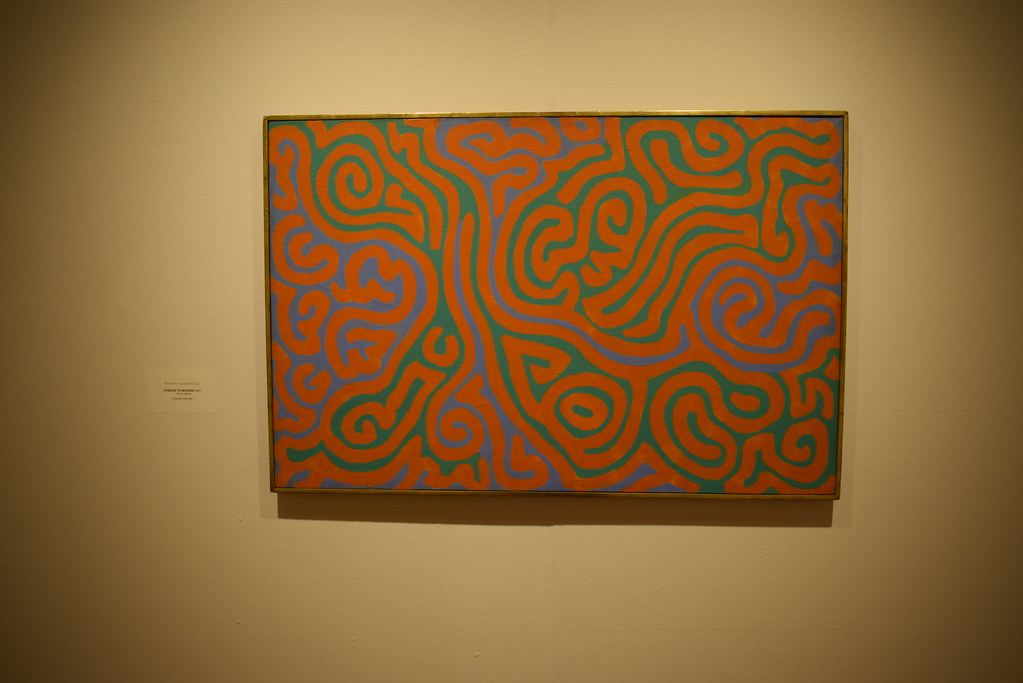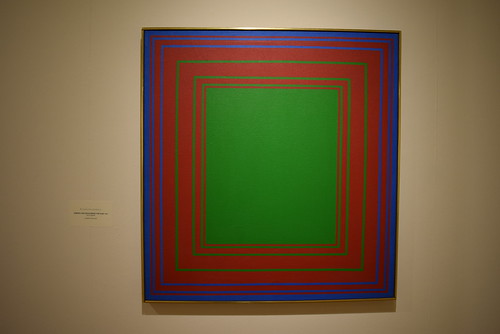Richard Anuszkiewicz was an American painter and sculptor known for his vibrant and meticulous Op ArtOp Art, short for Optical Art, is a visual art movement that emerged in the 1960s, characterized by the use of geometric patterns, contrasting colors, and optical illusions to create a sense of movement or vibration. This art form plays with visual perception, engaging the viewer in dynamic and sometimes disorienting visual experiences. Origins and Development Op Art gained prominence More works. His art focuses on the optical effects of color and form, creating dynamic visual experiences that engage and challenge the viewer’s perception.

Early Life and Career
Richard Anuszkiewicz was born on May 23, 1930, in Erie, Pennsylvania. He studied at the Cleveland Institute of Art and later at Yale University under the renowned color theorist Josef AlbersJosef Albers (1888–1976) was a German-American artist, educator, and influential figure in the fields of color theory and abstract art. Known for his profound impact on modern art education, Albers' work emphasized the perception and interaction of color. Born in Bottrop, Germany, Albers initially trained as a schoolteacher before pursuing his passion for art. He studied at the Bauhaus, where More. This education deeply influenced his understanding and use of color, which became a central element of his work. Anuszkiewicz emerged as a leading figure in the Op ArtOp Art, short for Optical Art, is a visual art movement that emerged in the 1960s, characterized by the use of geometric patterns, contrasting colors, and optical illusions to create a sense of movement or vibration. This art form plays with visual perception, engaging the viewer in dynamic and sometimes disorienting visual experiences. Origins and Development Op Art gained prominence More movement in the 1960s.
Artistic Style
Anuszkiewicz’s style is characterized by:
- Vibrant Colors: He uses intense, contrasting colors to create optical vibrations and dynamic visual effects.
- Geometric Precision: His works feature precise geometric shapes and patterns, often arranged in symmetrical compositions.
- Optical Illusions: Anuszkiewicz’s art plays with the viewer’s perception, creating the illusion of movement and depth on a flat surface.
- Influence of Color TheoryColor Theory is a comprehensive framework used to understand and analyze the use and interaction of colors in visual compositions. It serves as a critical guide for artists, designers, and marketers, helping them create harmonious and effective designs. This concept encompasses various principles and elements that dictate how colors are combined, perceived, and utilized. Primary Colors: • The three foundational More: Strongly influenced by Josef AlbersJosef Albers (1888–1976) was a German-American artist, educator, and influential figure in the fields of color theory and abstract art. Known for his profound impact on modern art education, Albers' work emphasized the perception and interaction of color. Born in Bottrop, Germany, Albers initially trained as a schoolteacher before pursuing his passion for art. He studied at the Bauhaus, where More, he explores the interaction of colors and their impact on visual perception.

Major Works
- “Celestial”: This work exemplifies Anuszkiewicz’s use of vibrant color gradients and geometric patterns to create a sense of celestial movement and depth.
- “Green Lion Devouring the Sun”: A striking piece that uses bold colors and sharp contrasts to evoke a mythical and dynamic visual experience.
- “Homage to Matisse”: A tribute to Henri MatisseFrench artist Henri Matisse (1869 – 1954) is, along with Pablo Picasso, commonly regarded as pioneers in the revolutionary development of the visual arts in the 20th century. He was born to generations of weavers and raised in the northern French commune Bohain, famous for its luxury fabrics. The early exposure to textiles strongly shaped his visual language, his sense More, this work incorporates Anuszkiewicz’s characteristic use of vibrant colors and precise geometric forms to celebrate the French artist’s influence on modern art.

Philosophical Influences
Anuszkiewicz’s work is deeply influenced by his interest in color theoryColor Theory is a comprehensive framework used to understand and analyze the use and interaction of colors in visual compositions. It serves as a critical guide for artists, designers, and marketers, helping them create harmonious and effective designs. This concept encompasses various principles and elements that dictate how colors are combined, perceived, and utilized. Primary Colors: • The three foundational More, perception, and the psychological impact of visual stimuli.
- Color TheoryColor Theory is a comprehensive framework used to understand and analyze the use and interaction of colors in visual compositions. It serves as a critical guide for artists, designers, and marketers, helping them create harmonious and effective designs. This concept encompasses various principles and elements that dictate how colors are combined, perceived, and utilized. Primary Colors: • The three foundational More: Building on the teachings of Josef AlbersJosef Albers (1888–1976) was a German-American artist, educator, and influential figure in the fields of color theory and abstract art. Known for his profound impact on modern art education, Albers' work emphasized the perception and interaction of color. Born in Bottrop, Germany, Albers initially trained as a schoolteacher before pursuing his passion for art. He studied at the Bauhaus, where More, Anuszkiewicz explored how colors interact and affect each other, focusing on their optical and emotional effects.
- Optical Perception: His art investigates how the eye perceives color and form, creating illusions that challenge the viewer’s visual perception.
- MinimalismMinimalism is an art movement that emerged in the late 1950s and early 1960s, primarily in the United States. It is characterized by its use of simple geometric forms, clean lines, and a focus on the materiality of the work itself. Minimalist art emphasizes simplicity and seeks to strip away any unnecessary elements to reveal the essence of the artwork. More and Precision: While visually vibrant, Anuszkiewicz’s works often align with minimalist principles through their use of simple, repetitive geometric forms.
Techniques and Materials
Anuszkiewicz employed various techniques and materials to achieve his distinctive style.
- Acrylic Paints: He used acrylic paints for their bright, saturated colors and ability to create smooth, flat surfaces.
- Geometric Patterns: His compositions are meticulously planned and executed, often involving the use of rulers and other tools to achieve precise geometric forms.
- Repetition and Symmetry: Anuszkiewicz frequently used repeated patterns and symmetrical arrangements to enhance the optical effects of his works.
Influence and Legacy
Richard Anuszkiewicz’s impact on contemporary art is significant, particularly in the fields of Op ArtOp Art, short for Optical Art, is a visual art movement that emerged in the 1960s, characterized by the use of geometric patterns, contrasting colors, and optical illusions to create a sense of movement or vibration. This art form plays with visual perception, engaging the viewer in dynamic and sometimes disorienting visual experiences. Origins and Development Op Art gained prominence More and color theoryColor Theory is a comprehensive framework used to understand and analyze the use and interaction of colors in visual compositions. It serves as a critical guide for artists, designers, and marketers, helping them create harmonious and effective designs. This concept encompasses various principles and elements that dictate how colors are combined, perceived, and utilized. Primary Colors: • The three foundational More. His innovative approach to color and form continues to inspire artists and designers.
- Op ArtOp Art, short for Optical Art, is a visual art movement that emerged in the 1960s, characterized by the use of geometric patterns, contrasting colors, and optical illusions to create a sense of movement or vibration. This art form plays with visual perception, engaging the viewer in dynamic and sometimes disorienting visual experiences. Origins and Development Op Art gained prominence More Movement: Anuszkiewicz is a central figure in the Op ArtOp Art, short for Optical Art, is a visual art movement that emerged in the 1960s, characterized by the use of geometric patterns, contrasting colors, and optical illusions to create a sense of movement or vibration. This art form plays with visual perception, engaging the viewer in dynamic and sometimes disorienting visual experiences. Origins and Development Op Art gained prominence More movement, influencing artists who explore optical effects and visual perception.
- Color TheoryColor Theory is a comprehensive framework used to understand and analyze the use and interaction of colors in visual compositions. It serves as a critical guide for artists, designers, and marketers, helping them create harmonious and effective designs. This concept encompasses various principles and elements that dictate how colors are combined, perceived, and utilized. Primary Colors: • The three foundational More and Education: His works serve as practical studies in color theoryColor Theory is a comprehensive framework used to understand and analyze the use and interaction of colors in visual compositions. It serves as a critical guide for artists, designers, and marketers, helping them create harmonious and effective designs. This concept encompasses various principles and elements that dictate how colors are combined, perceived, and utilized. Primary Colors: • The three foundational More, offering valuable insights for artists and students of art.
- Contemporary Design: Anuszkiewicz’s vibrant and precise patterns have influenced graphic design, fashion, and interior design, demonstrating the crossover between fine art and applied arts.
Major Exhibitions and Collections
Anuszkiewicz’s works have been featured in numerous major exhibitions and are held in prominent collections worldwide.
- The Museum of Modern Art (MoMA): New York’s MoMA features several of Anuszkiewicz’s pieces, showcasing his contributions to Op ArtOp Art, short for Optical Art, is a visual art movement that emerged in the 1960s, characterized by the use of geometric patterns, contrasting colors, and optical illusions to create a sense of movement or vibration. This art form plays with visual perception, engaging the viewer in dynamic and sometimes disorienting visual experiences. Origins and Development Op Art gained prominence More and contemporary art.
- The Whitney Museum of American Art: The Whitney has exhibited Anuszkiewicz’s works, emphasizing his impact on American art.
- The Cleveland Museum of Art: This museum holds a significant collection of Anuszkiewicz’s works, reflecting his roots in Ohio and his influence on modern art.
Conclusion
Richard Anuszkiewicz remains a pivotal figure in contemporary art, celebrated for his innovative use of color and optical effects. His contributions continue to influence and inspire artists and viewers alike, highlighting the enduring fascination with visual perception and the dynamic interplay of color and form.
Further Reading
For those interested in exploring Richard Anuszkiewicz’s life and work further, consider these sources:
